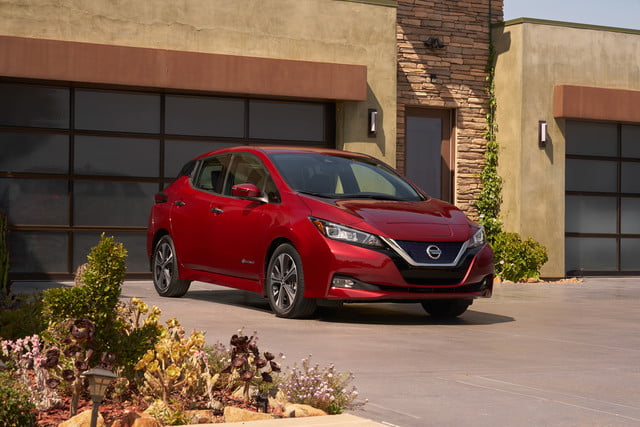
The Leaf and the Model 3 are a lot alike in some ways, and polar opposites in others. We break down the differences and the similarities.
Tech features
The Leaf ushers in Nissan’s ProPilot Assist technology. Offered at an extra cost, it’s a suite of electronic driving aids designed to help out when driving becomes tedious, dangerous, or plain boring. It functions in stop-and-go traffic on single-lane highways, and it’s active between 18 and 62 mph. It controls braking, acceleration, and steering. It doesn’t turn the Leaf into a fully autonomous car, but Nissan hinted it will add more features to ProPilot Assist in the coming years. Full autonomy is the company’s end goal, though it’s several years away from becoming a reality.
The Model 3 is available with Tesla’s Autopilot technology as an option. When the right conditions are met, the Model 3 is capable of changing lanes, reading speed limit signs, navigating freeway offramps, and even parking all by itself. Autopilot sets buyers back $5,000, so it’s not cheap by any means, but it makes the Model 3 considerably more high-tech than the Leaf. Like Nissan, Tesla promises it will roll out full autonomy as soon as engineers, lawmakers, and consumers are finally in sync.
Performance and range
This is the area in which the Leaf and the Model 3 differ the most. The Leaf’s drivetrain consists of an electric motor that zaps the front wheels with 147 horsepower and 236 pound-feet of instant torque. Its 40-kWh lithium-ion battery pack only provides 150 miles of range, which is much better than the last-gen model’s 107-mile range but still not enough to tick the coveted “long-range” box. Nissan promises a second version of the Leaf with more power and more range will join the lineup in time for the 2019 model year. Rumors point to 200 miles of range, though nothing is official yet.
Tesla has opted not to release official horsepower and torque figures for the Model 3. In its most basic configuration, the rear-wheel drive sedan offers a 50-kWh lithium-ion battery pack that delivers up to 220 miles of range. Buyers willing to spend an extra $9,000 can unlock a 70-kWh battery with 310 miles of range.
The Model 3 performs the benchmark 0-to-60-mph sprint in 5.6 seconds with the smaller battery, and in 5.1 seconds with the bigger unit. Nissan hasn’t released performance figures for the Leaf yet.
Interior and exterior design
Both EVs are well executed; the Leaf looks more grown-up and far less alien ship-esque than its predecessor, while the Model 3 adopts styling cues from the bigger Model S and Model X. Beauty is in the eye of the beholder, so we won’t comment on which one looks better.
The respective designs highlight the fact that, powertrain and price aside, the Leaf and the Model 3 are significantly different answers to the same question. The Leaf is a big hatchback developed with an emphasis on practicality and ease of use, and its style reflects that. The Model 3 is a compact sedan that plays the premium card to lure buyers away from the Mercedes-Benz C-Class and the BMW 3 Series, and it certainly looks the part.

It’s the same story when you open the door and take a peek inside the cabin. The Leaf has the components you’d expect to find in a non-electric car, including a digital instrument cluster, a three-spoke steering wheel, a touchscreen, and a gear selector. They’re all where you’d expect to find them, too. The Model 3 takes a fabulously minimalist approach to design with a large, television-like touchscreen that replaces every single button, switch, and gauge. The sloping center console and the chrome highlights add an upscale touch that’s lacking in the Leaf, while again highlighting its more upmarket positioning.
Pricing and availability
The 2018 Nissan Leaf will arrive in showrooms early next year with a base price of $29,990, a figure that makes it nearly $700 cheaper than its predecessor. That’s before incentives from the local and federal government are factored in. Getting one is straightforward — scratch together some cash or a loan, hightail it over to the nearest dealer, and drive home in a new car. There’s no need to spend a year (or more) waiting in a virtual line.
The Model 3 starts at $35,000 before incentives and options (like the long-range battery pack) are thrown into the equation. Tesla started production of the Model 3 in July, and the first cars are already crisscrossing the nation’s roads, though the company admits it’s in “production hell” right now. The company is working through a backlog of orders as it ramps up production, and delivery wait times are getting excruciatingly long. Customers who make a deposit in late 2017 might not receive their car until 2019.



